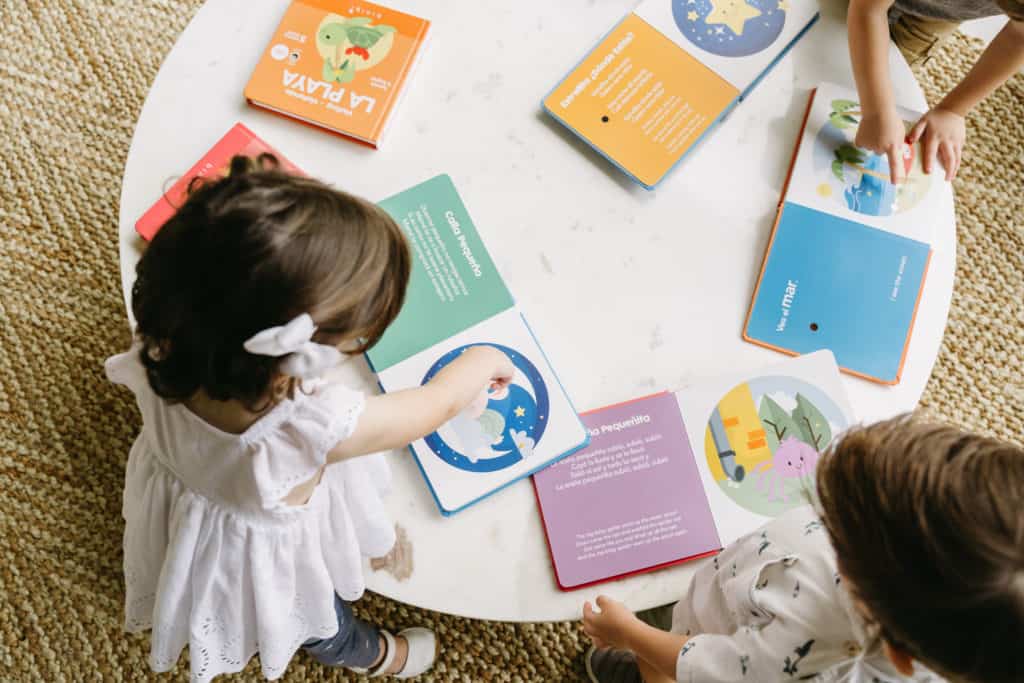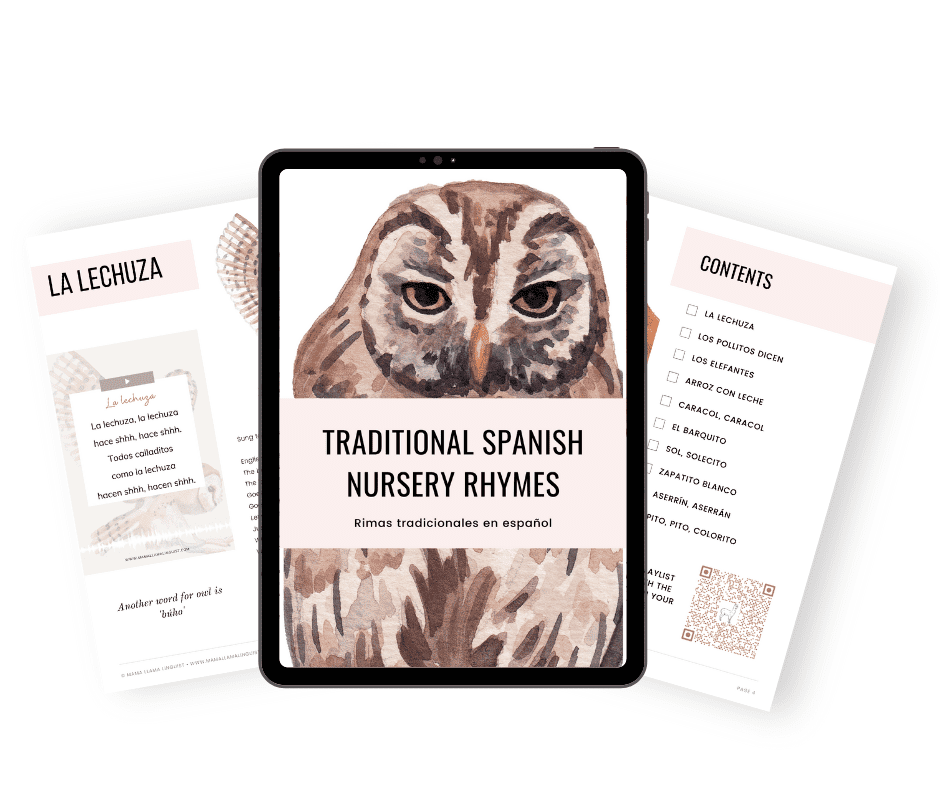In this post: A round-up of some of the most authentic Spanish nursery rhymes to teach your kids. Includes a FREE ‘rimas tradicionales’ download with music and lyrics.
Spanish nursery rhymes are a popular tool and bonding experience for bilingual families with young kids. Learning Spanish nursery rhymes not only supports memorization and language development, but also nurtures a deeper appreciation for Spanish and Latin American cultures.
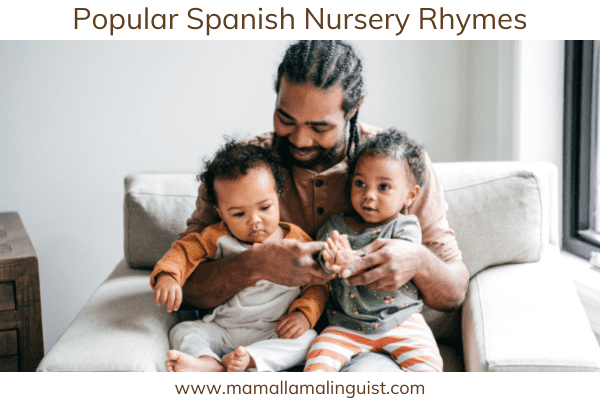
This post contains affiliate links. As an Amazon associate I earn from qualifying purchases.
From babies to elementary aged kids, the following authentic Spanish nursery rhymes will support you in practicing the Spanish language in a fun and interactive way at home.
Table of Contents
How do you say ‘Nursery Rhymes’ in Spanish?
The Spanish translation for Nursery Rhymes is ‘rimas tradicionales’. There are also ‘canciones de cuna’ which are lullabies and ‘canciones infantiles’ which are more generic children’s songs.
Rimas tradicionales en español refers to more authentic, Spanish nursery rhymes that are rich in culture and traditions.
Related Post: Canciones infantiles on YouTube
Best Spanish Nursery Rhyme Books
There are so few musical books in Spanish out there! Which is why I was over the moon to discover Binibi books!
These gorgeous nursery rhyme books are perfect for toddlers and preschoolers. They have two nursery rhyme sing-along titles and two sound books!
We got The Collection Bundle and I highly recommend them to any family looking for meaningful, interactive, bilingual books for their children.
Related Post: Musical Spanish Books for Babies and Toddlers
Nursery Rhymes in Llamitas Spanish
Nursery rhymes offer the perfect opportunity to practice phonics and early memory work through repetition and recitation. All of which are foundational skills to develop in early years education.
Our Llamitas Spanish curriculum is a done-for-you, Spanish language arts program, that includes phonics work, literacy and ‘cantos’ (recitations) in a series of thematic units for ages 3-6.
Our recitations are short enough for the child to be able to memorize. The native speaker audio also supports non-native speakers, so can hear the pronunciation and practice together.

Explore the Llamitas Spanish curriculum here.
10 Authentic Spanish Nursery Rhymes
Here is a round-up of the top ‘rimas tradicionales’ in our bilingual home.
We are including the lyrics in Spanish, but you can find the English translations and the music playlist in our FREE Spanish Nursery Rhymes Anthology.
Los pollitos dicen
This was the first Spanish nursery rhyme I ever taught my children! It also continues to be one of their favorites. The lyrics are so catchy and easy to memorize.
“Los Pollitos Dicen” has been a popular lullaby that Latina moms sing to their newborns for generations. The song is so deeply connected to the Latin culture, that many moms refer to their babies as “pollitos”.
Pair with this cute board book from Canticos.
Los pollitos dicen
pío, pío, pío
cuando tienen hambre
cuando tienen frío.
La Gallina busca
el maíz y el trigo
les da la comida
y les presta abrigo.
Bajo sus dos alas
acurrucaditos
hasta el otro día
duermen los pollitos.
Cuando se despiertan
dicen mamacita,
tengo mucha hambre
dame lombricitas.
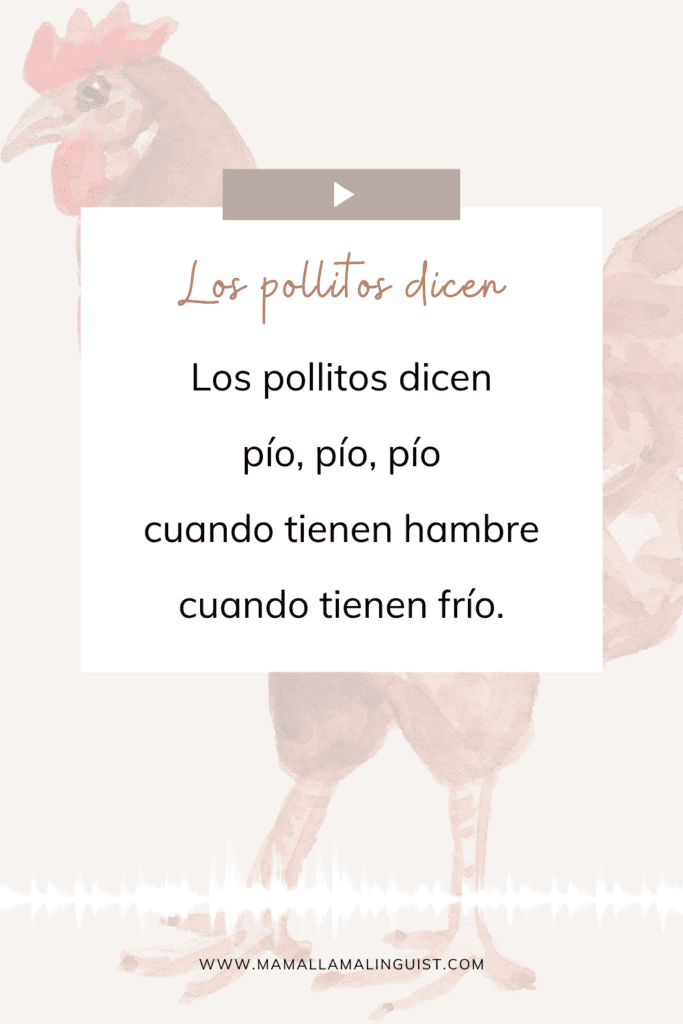
Los elefantes
This traditional nursery rhyme in Spanish is great for gross movement. Get your child to hold a scarf on one end, while you take the other. Then pop a stuffed animal in the middle (ideally an elephant, but any will do). Sing the song and bounce the toy up and down in the scarf, trying not to let it fall out.
Your child will also practice counting to 10!
Pair with this adorable book by Lil’Libros.
Un elefante se balanceaba
sobre la tela de una araña
como veía que resistía
fue a llamar a otro elefante.
Dos elefantes se balanceaban
sobre la tela de una araña
como veían que resistía
fueron a llamar a otro elefante.
Tres elefantes ….
Sol, solecito
This is such a happy song about the sun! It is also a great way to teach your kids the days of the week in Spanish. We really love the Canticos version.
Pair with this title from Canticos.
Sol solecito
caliéntame un poquito.
por hoy, por mañana,
por toda la semana.
Lunes
martes
miércoles
jueves
viernes
sábado
domingo.
Luna lunera
cascabelera,
mañana volaré
porque el mundo me espera.
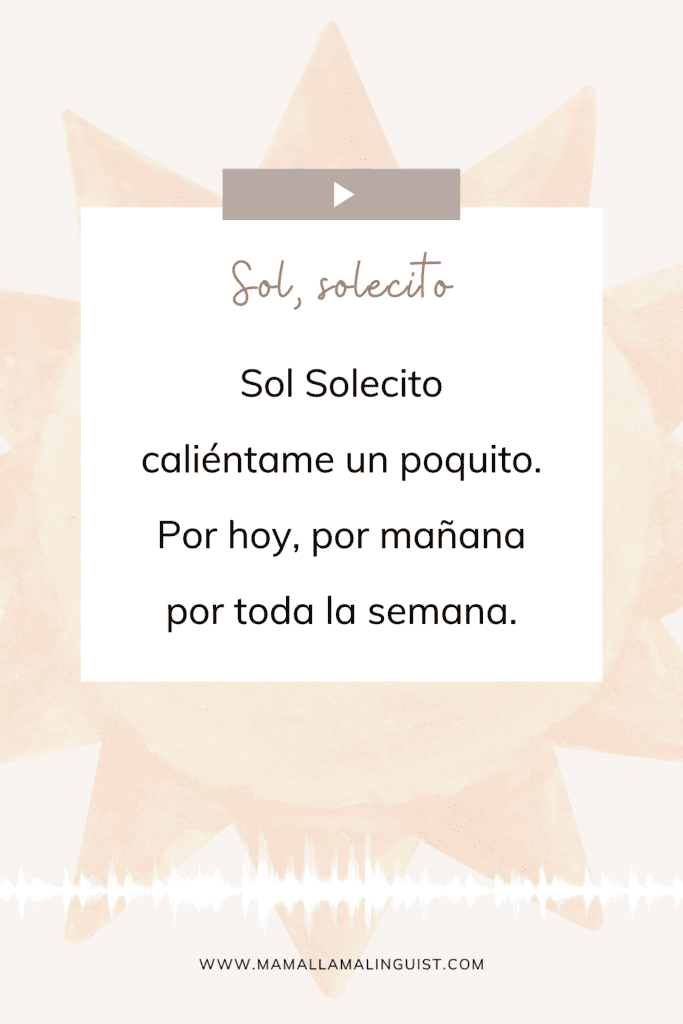
La lechuza
We love Spanish lullabies or ‘canciones de cuna’. One that I have sung to my children since they were tiny babies is ‘La lechuza’.
It is very short but so pretty and relaxing with the ‘shhhh’. Even now I find myself singing it to soothe them all these years later! My children also tell me that their teacher uses it to calm the class down.
Pair with this musical book from Lufi & Friends.
La lechuza, la lechuza
hace shhh, hace shhh
todos calladitos como la lechuza
hacen shhh, hacen shhh.
See, I told you it was short! I typically repeat it several times.
Zapatito blanco
A fun rhyme that is often used to determine who is ‘It’ in a game- or who goes first. The English equivalent would be ‘Eeeney, meeney, miney, moe’.
Zapatito blanco
zapatito azul
¡dime cuantos años tienes tú!
¡Diez! 1, 2, 3, 4, 5, 6, 7, 8, 9, 10 (whoever 10 lands on is out of the game)
Zapatito blanco
zapatito azul
¡dime cuantos años tienes tú!
¡Siete! 1, 2, 3, 4, 5, 6, 7 (and then whoever 7 lands on is out of the game, and so forth until the final two left in the game play rock, paper, scissors.)
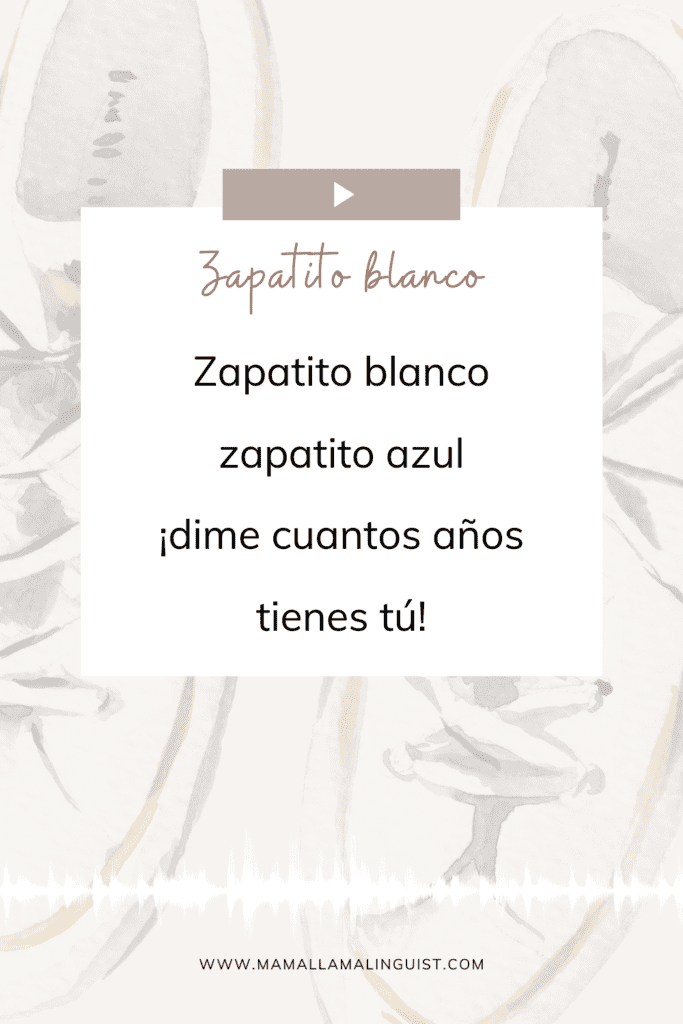
Aserrín, aserrán
This traditional Spanish nursery rhyme mentions the Feast of San Juan, celebrated on June 24 for the birth of John the Baptist. It is a great song to bounce your child on your knee, swaying them back and forth.
Find it in this beautiful anthology from Pio Peep.
Aserrín, aserrán
los maderos de San Juan.
Piden pan
no les dan
piden queso
les dan un hueso
Se les atora en el pescuezo
piden vino, si les dan
se marean y se van.
Arroz con leche
This traditional nursery rhyme is sung all over the Spanish speaking world. It is often sung during a children’s game where they stand in a circle with one child in the middle. The other children walk around holding hands and singing the song.
During the verse “Con éste (or ésta) sí”, the child points to another child. Then proceeds to point to another child for “Con éste (or ésta) no”. Then points back to the first one again for the verse “Con esta señorita (or este señorito) me caso yo”. These two children hold hands and dance in the circle.
Pair with this stunning collection of authentic nursery rhymes
Arroz con leche
me quiero casar
con una señorita
de la capital.
Que sepa coser
que sepa bailar
que sepa abrir la puerta
para ir a jugar.
Con ésta sí
con ésta no
con esta señorita
me caso yo.
Related Post: Spanish Poetry Books for Kids
El barquito
This repetitive nursery rhyme features in our Ocean Unit in the Llamitas Spanish curriculum. It is a great way to practice counting 1-7 quickly too!
Find it in this beautiful anthology from Pio Peep.
Había una vez un barco chiquitico.
Había una vez un barco chiquitico.
Había una vez un barco chiquitico
que no sabía, que no sabía, que no sabía navegar.
Pasaron una, dos, tres, cuatro, cinco, seis, siete semanas.
Pasaron una, dos, tres, cuatro, cinco, seis, siete semanas.
Pasaron una, dos, tres, cuatro, cinco, seis, siete semanas
y el barquito, y el barquito, y el barquito, no podía navegar.
Y si la historia no te parece larga.
Y si la historia no te parece larga.
Y si la historia no te parece larga
volveremos, volveremos, volveremos a empezar.
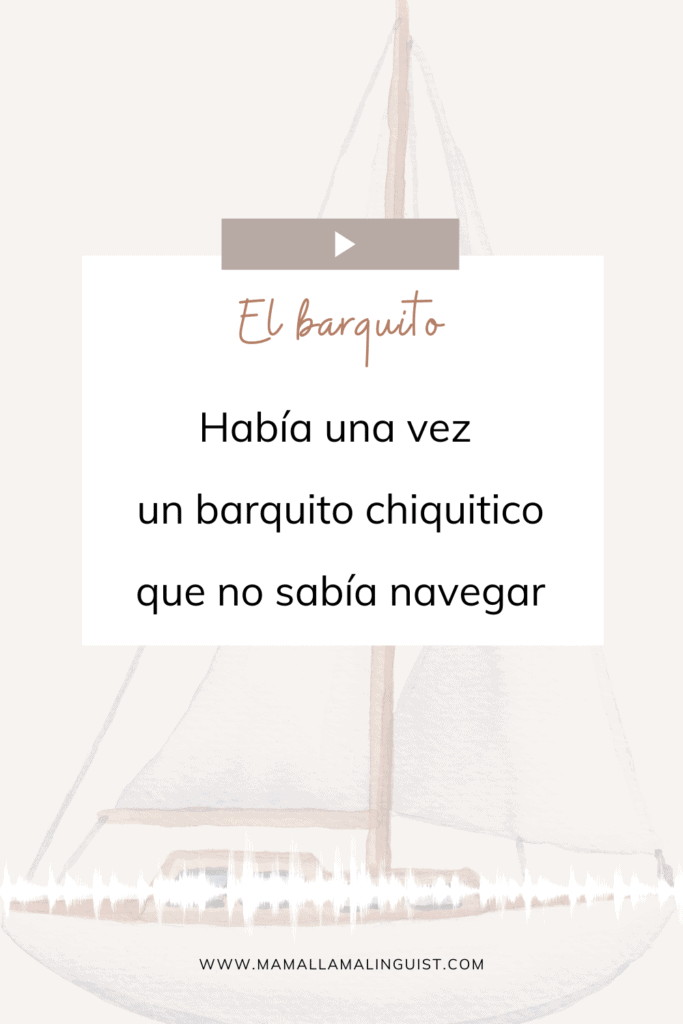
Caracol, caracol
I absolutely love using the children’s book ¿Dónde vives caracol? as a book pairing. This nursery rhyme is perfect for singing out in the garden after the rain. Go searching for snails and point out their ‘cuernos’ ~ tentacles.
Caracol, -col, -col
saca tus cuernos al sol
saca uno, saca dos
caracol, -col, -col.
Si saca la cabeza y los cuernitos
cuando hay sol
seguro que es un bicho
que se llama caracol.
Caracol, -col, -col
saca tus cuernos al sol
saca uno, saca dos
caracol, -col, -col.
There is also a shorter version as seen in the graphic below.
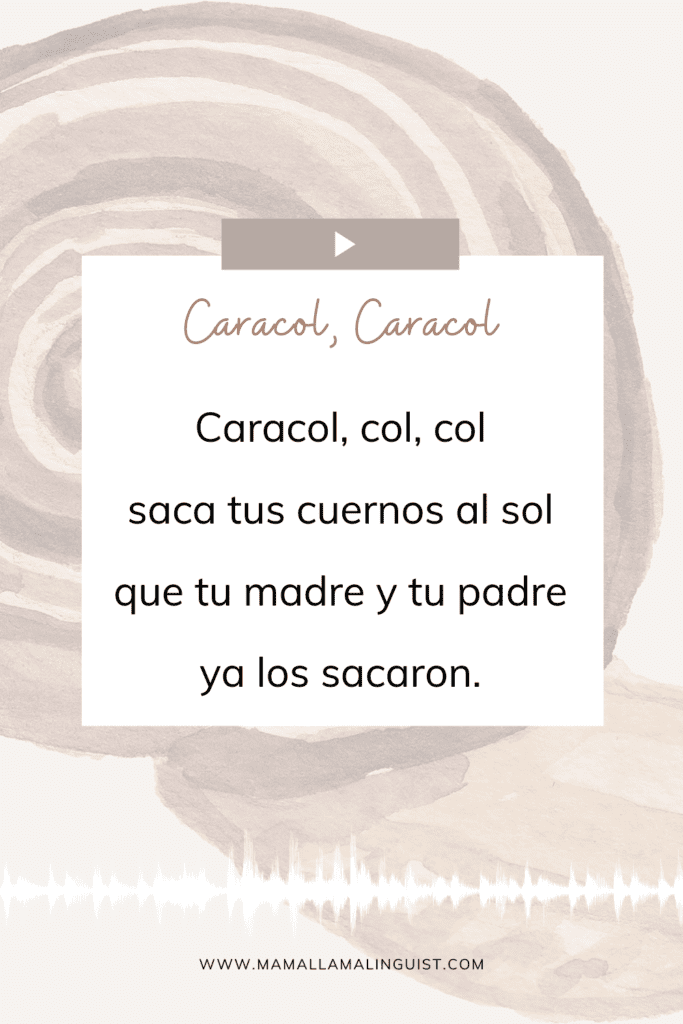
Pito, pito, colorito
This short nursery rhyme has a staccato rhythm that almost sounds like rain falling. I just love singing it as we are look out for birds from our front room and look up the name of each type in our Bird Watch book for kids.
Pito, pito, colorito
¿dónde vas tú, tan bonito?
Voy al campo de la era
a la escuela verdadera.
Don’t forget to download your FREE anthology with music playlist of all these beautiful Spanish nursery rhymes!
Related Post:
Founder of the Llamitas Spanish® Curriculum and former Spanish teacher. Corrie holds a Masters in Spanish and Education and is raising bilingual children in San Diego, CA.

